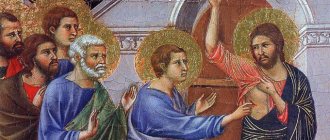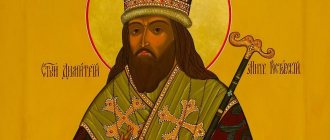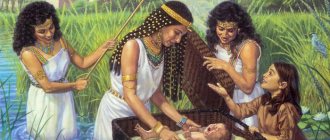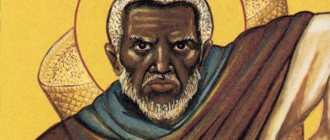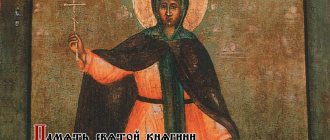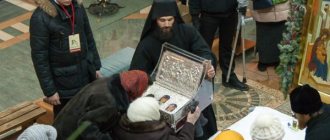Brief biography of the saint
The apostle's life is proof of how faith can change a person. The meeting with Jesus became a turning point in the fate of a simple fisherman.
Origin
Simon was born in Palestine, in the town of Bethsaida. The exact date of birth is unknown. He was executed in 67 AD. He received the name Peter from Jesus. He was a man with a lively temperament, but firm and purposeful by nature.
Together with his brother Andrei, Simon fished in the lake to feed his family: his wife and two children. The biography of Peter, one of Jesus' most beloved disciples, is recorded in the Acts of the Apostles.
Life and deeds
The Gospel describes the meeting of the brothers with the Savior while fishing. Time after time they cast their nets into the waters of Lake Gennesaret, but the fish did not go into the net. Jesus saw the distress of Andrew and Simon and performed a miracle: an unprecedented catch filled the boat to the brim.
Simon was frightened, but Jesus encouraged him, saying that he would now become a fisher of human souls, and named him Peter, which in Greek means stone.
Simon believed that the living God was before him, left his family, home and became a disciple of Jesus. But before becoming the first among the apostles to preach the teachings of Christ, he went through a difficult path of testing his faith. Peter was one of the most trusted disciples of Jesus Christ. He is the only one of the apostles who answered the Savior’s question three times who they take him for, that Jesus is the Christ, the son of the living God. The Son of God saw in Peter an ardent and faithful companion who would help found the Church and would be a mediator between people and God after death:
- “...on this rock I will build my Church...”
- “...and I will give you the keys to the Kingdom of Heaven and...whatever you loose on earth will be loosed in heaven.”
Peter witnessed the Transfiguration of Jesus on Mount Tabor.
Renunciation
Peter did not want his beloved Teacher to condemn himself to cruel torment and death, and dissuaded him from going to Jerusalem. For his words, he received a harsh rebuke from Jesus Christ. To meet the inevitable, the Savior went to the Garden of Gethsemane, accompanied by Peter, James and John. The disciples fell asleep while Jesus was praying, for which he reproached them. Peter, feeling guilty, said that he would never give up on the Teacher, to which Jesus predicted that he would betray him three times before the first cock crow.
The prophetic words came true: fear for his life forced Peter to deny Christ three times before dawn. After Jesus was arrested by the guards of the high priest Caiaphas, he followed Christ into the courtyard, where he was recognized. Three of the servants pointed to him as a disciple of Jesus, and Peter denied it. With the rooster crowing, he remembered the Teacher’s words, and deep remorse for his cowardice overwhelmed him.
Preaching Christ
After the death, resurrection and ascension of Jesus Christ, Peter became a missionary, preaching the teachings of Christ. He made his first speech to the apostles about choosing the 12th apostle instead of the traitor Judas. Peter had the power of persuasion, explaining the doctrine in clear language. After his sermon, thousands of people accepted the Christian faith.
Thanks to the Holy Spirit, he was able to heal and resurrect people like the Savior, as written in the Acts of the Apostles:
- On the day of Pentecost, Peter spoke to the Israelites in Jerusalem. His speech made a huge impression on the crowd. He shamed the people for executing the Messiah, explained what their error was, and called on them to repent and accept the faith of Christ.
- Peter and John saw a frail disabled man near the church, deprived of the ability to walk from birth. The Apostle took him by the hand and told him to get up and start walking. Seeing the amazement of those around him, he explained to them that it was not magic, but faith in Jesus Christ that cured the lame man.
- The Apostle restored health to Aeneas, who had not risen for 8 years due to paralysis, and resurrected Tabitha.
The preacher not only healed, but also punished for lying before the Lord. He put the married couple, Ananias and Sapphira, who withheld part of the amount from the sale of the estate and tried to present themselves as donors to the Lord, to death.
Simon Magus
The tireless and undaunted missionary converted not only Jews, but also pagans in Syria, in the territory of modern Turkey, Greece, Rome, and Babylon to the faith of Christ. Among the converts there were people who sought to achieve ambitious goals through the adoption of Christianity.
Such was the pagan priest Simon, who was baptized by Philip in Samaria. Simon knew magic spells that affected people. Having learned that through the apostles Peter and John the Holy Spirit descends on Christians, he wanted to become like them and offered Peter money for his ordination as a successor. Peter drove him away with an angry rebuke.
First and Second Messages
There are two known letters of Peter. In the first he addresses Christian converts in the communities of Asia Minor. The Apostle instructs them to love and support each other, and not to be afraid of persecution. The second was written shortly before his death. In it, the saint warns not to succumb to false prophets and not to deviate from the tenets of Christianity.
Escape from prison
By order of King Herod, the Apostle James was killed, and Peter was captured and imprisoned. At night, a guardian angel appeared to him and led him out of prison, invisible to the guards. Coming out of prison, the saint went to the house of Mark’s mother, where Christians gathered and prayed for his fate. The preacher told them about his miraculous liberation and moved on.
Death and canonization
For the last 20 years, Peter lived in Rome, preaching and strengthening the Christian faith. Emperor Nero, having come to power, resumed the persecution of Christians. The apostle decided to leave the city in which he was threatened with death. Going beyond the city limits, he saw Jesus Christ heading to Rome.
When asked why he was going to Rome, Christ answered that he was going to be crucified. Peter was ashamed of his cowardice and returned back. He realized that he must walk the path of the Teacher, accepting martyrdom. Peter died in 67 AD, crucified on the cross. Before execution, he asked to turn the cross upside down so as not to desecrate the memory of the Savior.
Description of the Basilica
Size . St. Peter's Basilica is still one of the largest churches in the world. It is the largest in area (internal area 15,160 m), length (external length - 211.5 m) and volume (5 million m, which is far larger than any other church in the world).
Dome . In plan, the church has a cruciform shape with a dome in the center. This gigantic dome dominates the skyline of Rome. This is one of the largest domes in the world and the highest (136.57 m). The diameter of the dome is 41.47 m - less than that of the Florence Cathedral, but, nevertheless, it is one of the greatest domes in the world. To make it lighter, the concrete was mixed with many pieces of light pumice and tuff (an ancient Roman formula rediscovered for this occasion), and it is also thin, with vertical and horizontal ribs to enhance sound (as in the Pantheon).
The design of the huge dome was inspired by the Pantheon , but there were significant differences. The huge dome rests on four pillars, and above it rises another smaller lantern dome.
St. Peter's Square . It is an attraction in itself, but largely creates the impression of the basilica.
In its current form, the square was built in 1656–1667. Gian Lorenzo Bernini and is one of the masterpieces of the Baroque style . Bernini had to create an urban ensemble that would attract the attention of visitors to the basilica. Of course, he had to preserve the Egyptian obelisk, an important milestone in the history of St. Peter's Basilica.
Bernini had different options for planning the area - square, trapezoid and several other shapes. His solution was different and innovative - he designed a space consisting of two elements: a trapezoidal square near the basilica and an open elliptical space further away, around the obelisk. In this way, Bernini managed to reduce the negative impact of the façade , making it seemingly narrower and taller. Both squares are surrounded by impressive colonnades. This original solution was one of the main manifestations of the Baroque style in urban planning with a complex harmonious play of various existing and newly added elements.
Entrance . After passing through the magnificent square, you can climb the huge staircase located between the statues of St. Peter (left) and St. Paul (right) and emerge onto the main façade of the church .
The northernmost of the five entrance doors is the Sacred Door , an ornate (everything here is decorated) door that is usually walled up with mortar and cement. It opens only on a special occasion : in jubilee years, which are declared by the Pope for the remission of sins. Previously, such celebrations were held every 33-25 years, but sometimes more often . In the 20th and 21st centuries, Anniversaries happen more often - apparently there are more sins, and they need to be forgiven.
Interior . The interior of St. Peter's Basilica is...incredibly vast. There are few buildings in the world with such a spacious interior and few with such an ornate interior . The size and beauty of the room dwarfs the people. It is so large that it is difficult for visitors to grasp the scale.
The huge nave is slightly inclined towards the Egyptian obelisk. The barrel vault of the nave is the highest in the world, flanked by numerous impressive chapels.
Behind the main altar are two staircases leading to an underground chapel - the Chapel of Confession, which is located above the place where St. Peter himself is said to be buried.
St. Peter's Chair . In the apse there is the Chair of St. Peter - a relic, a legendary chair that, according to legend, was used by St. Peter (in fact, a gift to the Pope in 875 AD). Later it was used by many popes. After being used for centuries, it fell into disrepair - so it was turned into a work of art. The chair is now encased in a beautiful gilded casing (Bernini, 1647 – 1653) - an outstanding and innovative (for its time) example of Baroque art.
Other relics . The basilica contains four precious relics - the spear of Longinus, which pierced Christ (although there are several other churches around the world that claim to have the same spear), Veronica's veil with the miraculous face of Christ, the cross brought by the mother of Emperor Constantine - Helen and the relics of the saint Andrew, brother of Saint Peter. Above the altar stands another outstanding work of art - the largest piece of bronze on Earth - 30 m high, a richly decorated canopy, also designed by Bernini.
Shrines
After his death, Peter was canonized. On the site of his grave, the Basilica of Constantine was erected in 326, which stood for 11 centuries. At the direction of Pope Julius II, St. Peter's Cathedral was erected in place of the ancient building, and services there resumed in 1626.
The relics of the saint are located under the Papal Throne, in the crypt, which is reached down a marble staircase. Near the central nave stands a bronze statue of the apostle. After prayer, pilgrims kiss the saint’s foot. In Russia, the memory of Christ’s beloved disciple was immortalized in the names of cities:
- Saint Petersburg;
- Petropavlovsk-Kamchatsky;
- Petrozavodsk.
The Apostle is considered the patron saint of the former capital of the Russian Empire.
Importance and influence
The basilica has been a place of pilgrimage for centuries and continues to attract visitors from all over the world. Technically it is only one of the four Papal Basilicas, but today it is the best known and most important of them. Because it is adjacent to the papal residence and is very large, most papal liturgies . These liturgies attract the attention of thousands of believers and tourists, and at times the gatherings can attract up to 80,000 people.
The architecture and art of this outstanding and impressive basilica has served as a source of inspiration throughout the world, influencing the views of art and beauty for many generations. The design of the basilica influenced the design of such magnificent buildings as St. Paul's Cathedral in London and the Pantheon in Paris.
Lyrics
In front of the icon, preachers and teachers of Christians ask for forgiveness of sins and strengthening in faith. Sailors turn to the former Simon the fisherman, praying for a safe return home. Faith in the apostle, the healer with the word of Christ, has survived to this day. In prayers he is asked for deliverance from physical and mental suffering.
Prayer
“O glorification to the apostles Peter and Paul, who gave up their souls for Christ and fertilized His pasture with your blood! Hear your children's prayers and sighs, now offered with contrite hearts. Behold, we are darkened by lawlessness and for this reason we are surrounded by troubles, like clouds, but the oil of a good life makes us poor. O strength! Bear our infirmities, do not be separated from us in spirit, so that we may not be completely separated from the love of God, but protect us with your strong intercession, may the Lord have mercy on us all for your prayers, and may He destroy the manuscripts knowledge of our immeasurable sins and may he be honored with all the saints of the blessed Kingdom and marriage of His Lamb, to Him be honor, and glory, and thanksgiving, and worship forever and ever. Amen".
